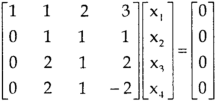Unit – 3
Matrices
Q1) What do you understand by elementary transformation?
A1)
Elementary transformation
A matrix can be transformed to another matrix by performing certain operations, we call these operations as elementary row operations and elementary column operations.
Definition-
“Two matrices A and B of same order are said to be equivalent to one another if matrix which need not be equal to the given matrix.
Elementary row and column operations-
- The interchanging of any two rows or columns of the matrix
- Replacing a row or column of the matrix by a non-zero scalar multiple of the row (column) by a non-zero scalar.
- Replacing a row or column of the matrix by a sum of the row (column) with a non-zero scalar multiple of another row or column of the matrix.
One can be obtained from the other by the applications of elementary transformations.”
Q2) Reduce the following matrix into row-echelon form-

A2)
We have-

Apply- 

Apply- 

Q3) Find the rank of a matrix A by echelon form.
A = 
A3)
Convert the matrix A into echelon form,
A = 
Apply 
A = 
Apply  , we get
, we get
A = 
Apply  , we get
, we get
A = 
Apply  ,
,
A = 
Apply  ,
,
A = 
Therefore the rank of the matrix will be 2.
Q4) Find the rank of the following matrices by echelon form?

A4)
Let A = 
Applying 
A 
Applying 
A 
Applying 
A 
Applying 
A 
It is clear that minor of order 3 vanishes but minor of order 2 exists as 
Hence rank of a given matrix A is 2 denoted by 
Q5) Example) Reduce the following matrix to normal form of Hence find it’s rank,

A5)
We have,





Apply 


 Rank of A = 1
Rank of A = 1
Q6) Find the rank of the following matrices by reducing it to the normal form.

A6)

Apply C14















Q7) Find the solution of the following homogeneous system of linear equations,




A7)
The given system of linear equations can be written in the form of matrix as follows,

Apply the elementary row transformation,


 , we get,
, we get,


 , we get
, we get

Here r(A) = 4, so that it has trivial solution,

Q8) Check whether the following system of linear equations is consistent of not.
2x + 6y = -11
6x + 20y – 6z = -3
6y – 18z = -1
A8)
Write the above system of linear equations in augmented matrix form,

Apply  , we get
, we get

Apply 

Here the rank of C is 3 and the rank of A is 2
Therefore both ranks are not equal. So that the given system of linear equations is not consistent.
Q9) Check the consistency and find the values of x , y and z of the following system of linear equations.
2x + 3y + 4z = 11
X + 5y + 7z = 15
3x + 11y + 13z = 25
A9)
Re-write the system of equations in augmented matrix form.
C = [A,B]
That will be,

Apply 

Now apply ,
We get,
 ~
~ ~
~
Here rank of A = 3
And rank of C = 3, so that the system of equations is consistent,
So that we can can solve the equations as below,

That gives,
x + 5y + 7z = 15 ……………..(1)
y + 10z/7 = 19/7 ………………(2)
4z/7 = 16/7 ………………….(3)
From eq. (3)
z = 4,
From 2,

From eq.(1), we get
x + 5(-3) + 7(4) = 15
That gives,
x = 2
Therefore the values of x , y , z are 2 , -3 , 4 respectively.
Q10) Are the vectors  ,
,  ,
,  linearly dependent. If so, express x1 as a linear combination of the others.
linearly dependent. If so, express x1 as a linear combination of the others.
A10)
Consider a vector equation,

i.e.




Which can be written in matrix form as,







Here  & no. Of unknown 3. Hence the system has infinite solutions. Now rewrite the questions as,
& no. Of unknown 3. Hence the system has infinite solutions. Now rewrite the questions as,


Put 
 and
and




Thus 
i.e.
i.e.


Since F11 k2, k3 not all zero. Hence  are linearly dependent.
are linearly dependent.
Q11) At what value of P the following vectors are linearly independent.

A11)
Consider the vector equation.

i.e.



This is a homogeneous system of three equations in 3 unknowns and has a unique trivial solution.
If and only if Determinant of coefficient matrix is non zero.
 consider
consider  .
.
 .
.
i.e.






Thus for  the system has only trivial solution and Hence the vectors are linearly independent.
the system has only trivial solution and Hence the vectors are linearly independent.
Q12) Determine the eigen values of eigen vector of the matrix.

A12)
Consider the characteristic equation as, 
i.e.
i.e.



i.e.
Which is the required characteristic equation.


 are the required eigen values.
are the required eigen values.
Now consider the equation
 … (1)
… (1)
Case I:
If  Equation (1) becomes
Equation (1) becomes

R1 + R2







Thus 
 independent variable.
independent variable.
Now rewrite equation as,


Put x3 = t
 &
&



Thus  .
.
Is the eigen vector corresponding to  .
.
Case II:
If  equation (1) becomes,
equation (1) becomes,









Here 
 independent variables
independent variables
Now rewrite the equations as,


Put 
 &
&



 .
.
Is the eigen vector corresponding to  .
.
Case III:
If  equation (1) becomes,
equation (1) becomes,











Here rank of 
 independent variable.
independent variable.
Now rewrite the equations as,


Put 

Thus  .
.
Is the eigen vector for  .
.
Q13) What is the diagonalization of square matrix?
Two square matrix and A of same order n are said to be similar if and only if
and A of same order n are said to be similar if and only if
 for some non singular matrix P.
for some non singular matrix P.
Such transformation of the matrix A into  with the help of non singular matrix P is known as similarity transformation.
with the help of non singular matrix P is known as similarity transformation.
Similar matrices have the same Eigen values.
If X is an Eigen vector of matrix A then  is Eigen vector of the matrix
is Eigen vector of the matrix 
Reduction to Diagonal Form:
Let A be a square matrix of order n has n linearly independent Eigen vectors which form the matrix P such that

Where P is called the modal matrix and D is known as spectral matrix.
Q14) Diagonalize the matrix 
A14)
Let A= 
The three Eigen vectors obtained are (-1,1,0), (-1,0,1) and (3,3,3) corresponding to Eigen values  .
.
Then  and
and 
Also we know that 




Q15) State Cayley-Hamilton theorem.
A15)
Every square matrix satisfies its characteristic equation, that means for every square matrix of order n,
|A -  | =
| = 
Then the matrix equation-

Is satisfied by X = A
That means

Q16) Find the characteristic equation of the matrix A =  and verify cayley-Hamlton theorem.
and verify cayley-Hamlton theorem.
A16)
Characteristic equation of the matrix, we can be find as follows-

Which is,
( 2 - , which gives
, which gives

According to cayley-Hamilton theorem,
 …………(1)
…………(1)
Now we will verify equation (1),


Put the required values in equation (1) , we get




Hence the cayley-Hamilton theorem is verified.
Q17) Using Cayley-Hamilton theorem, find  , if A =
, if A =  ?
?
A17)
Let A =
The characteristics equation of A is 


Or 
Or 
By Cayley-Hamilton theorem 
L.H.S. 
=
By Cayley-Hamilton theorem we have 
Multiply both side by 
 .
.

Or 
=
=
Q18) Find the inverse of matrix A by using Cayley-Hamilton theorem.
A = 
A18)
The characteristic equation will be,
|A -  | = 0
| = 0

Which gives,
(4-

According to Cayley-Hamilton theorem,

Multiplying by 

That means

On solving,
11
= 
= 
So that,

Q19) Find the inverse of matrix A by using Cayley-Hamilton theorem.
A = 
A19)
The characteristic equation will be,
|A -  | = 0
| = 0
= 
= (2-
= (2 - 
= 
That is,

Or

We know that by Cayley-Hamilton theorem,
 …………………….(1)t,
…………………….(1)t,
Multiply equation(1) by  , we get
, we get

Or

Now we will find 
= 

= 
Hence the inverse of matrix A is,
